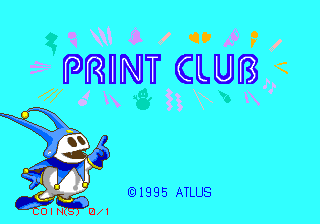Difference between revisions of "Print Club"
From Sega Retro
| Line 1: | Line 1: | ||
| − | |||
{{Bob | {{Bob | ||
| bobscreen=Print club.png | | bobscreen=Print club.png | ||
Revision as of 09:33, 13 March 2021
| Print Club | |||||||||||||
|---|---|---|---|---|---|---|---|---|---|---|---|---|---|
| System(s): Sega System C2 | |||||||||||||
| Publisher: Sega | |||||||||||||
| Developer: Atlus, Sega AM4[1] | |||||||||||||
| Genre: ETC | |||||||||||||
| Number of players: 1 | |||||||||||||
|
This teeny-tiny article needs some work. You can help us by expanding it.
Print Club (プリント倶楽部) is a arcade machine developed as a joint venture between Atlus and Sega and originally released in 1995.
For ¥300, a Print Club machine will take a of a user's face, allow them to customise the image by adding borders or extra graphics, and then print a sheet of 16 2.5x2cm stickers. While relatively basic in design, the concept proved to be extremely popular in Japan, particularly among young girls, to the point where it was considered a cultural phenomenon in the mid-to-late 1990s. Being an Atlus product, the machine's software prominently features Jack Frost from the Megami Tensei series.
The term "purikura" (プリクラ), used in Japan to collectively describe these machines (both Sega and otherwise), is a shortened version of Atlus/Sega's "Print Club" trademark. Like much of the developed world, photo booths had existed in Japan prior to the release of Print Club, but none were specifically marketed as a form of entertainment.
Photo gallery
Physical scans
| System C2, JP | ||||
|---|---|---|---|---|
| System C2, US | ||||
|---|---|---|---|---|


